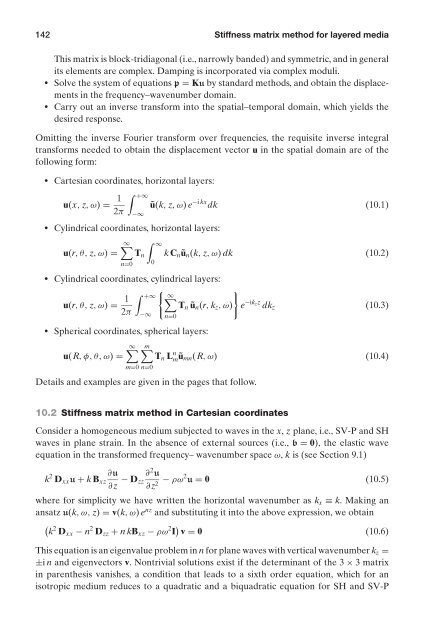Eduardo Kausel-Fundamental solutions in elastodynamics_ a compendium-Cambridge University Press (2006)
You also want an ePaper? Increase the reach of your titles
YUMPU automatically turns print PDFs into web optimized ePapers that Google loves.
142 Stiffness matrix method for layered media<br />
This matrix is block-tridiagonal (i.e., narrowly banded) and symmetric, and <strong>in</strong> general<br />
its elements are complex. Damp<strong>in</strong>g is <strong>in</strong>corporated via complex moduli.<br />
Solve the system of equations p = Ku by standard methods, and obta<strong>in</strong> the displacements<br />
<strong>in</strong> the frequency–wavenumber doma<strong>in</strong>.<br />
Carry out an <strong>in</strong>verse transform <strong>in</strong>to the spatial–temporal doma<strong>in</strong>, which yields the<br />
desired response.<br />
Omitt<strong>in</strong>g the <strong>in</strong>verse Fourier transform over frequencies, the requisite <strong>in</strong>verse <strong>in</strong>tegral<br />
transforms needed to obta<strong>in</strong> the displacement vector u <strong>in</strong> the spatial doma<strong>in</strong> are of the<br />
follow<strong>in</strong>g form:<br />
Cartesian coord<strong>in</strong>ates, horizontal layers:<br />
∫ +∞<br />
u(x, z,ω) = 1 ũ(k, z,ω) e −i kx dk (10.1)<br />
2π −∞<br />
Cyl<strong>in</strong>drical coord<strong>in</strong>ates, horizontal layers:<br />
∞∑<br />
∫ ∞<br />
u(r,θ,z,ω) = T n kC n ũ n (k, z,ω) dk (10.2)<br />
n=0<br />
0<br />
Cyl<strong>in</strong>drical coord<strong>in</strong>ates, cyl<strong>in</strong>drical layers:<br />
u(r,θ,z,ω) = 1 ∫ { }<br />
+∞ ∞∑<br />
T n ũ n (r, k z ,ω) e −ikzz dk z (10.3)<br />
2π −∞ n=0<br />
Spherical coord<strong>in</strong>ates, spherical layers:<br />
∞∑ m∑<br />
u(R,φ,θ,ω) = T n L n mũmn(R,ω) (10.4)<br />
m=0 n=0<br />
Details and examples are given <strong>in</strong> the pages that follow.<br />
10.2 Stiffness matrix method <strong>in</strong> Cartesian coord<strong>in</strong>ates<br />
Consider a homogeneous medium subjected to waves <strong>in</strong> the x, z plane, i.e., SV-P and SH<br />
waves <strong>in</strong> plane stra<strong>in</strong>. In the absence of external sources (i.e., b = 0), the elastic wave<br />
equation <strong>in</strong> the transformed frequency– wavenumber space ω, k is (see Section 9.1)<br />
k 2 ∂u<br />
D xx u + kB xz<br />
∂z − D ∂ 2 u<br />
zz<br />
∂z − 2 ρω2 u = 0 (10.5)<br />
where for simplicity we have written the horizontal wavenumber as k x ≡ k. Mak<strong>in</strong>g an<br />
ansatz u(k,ω,z) = v(k,ω) e nz and substitut<strong>in</strong>g it <strong>in</strong>to the above expression, we obta<strong>in</strong><br />
(<br />
k 2 D xx − n 2 D zz + n kB xz − ρω 2 I ) v = 0 (10.6)<br />
This equation is an eigenvalue problem <strong>in</strong> n for plane waves with vertical wavenumber k z =<br />
±i n and eigenvectors v. Nontrivial <strong>solutions</strong> exist if the determ<strong>in</strong>ant of the 3 × 3 matrix<br />
<strong>in</strong> parenthesis vanishes, a condition that leads to a sixth order equation, which for an<br />
isotropic medium reduces to a quadratic and a biquadratic equation for SH and SV-P



